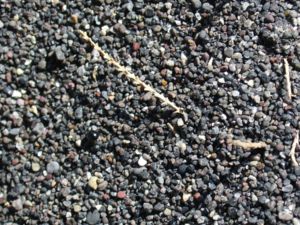Sand
2007 Schools Wikipedia Selection. Related subjects: Geology and geophysics
Sand is a granular material made up of fine rock particles. Sand is a naturally occurring, finely divided rock, comprising particles or granules ranging in size from 0.0625 (or 1⁄16) to 2 millimeters. An individual particle in this range size is termed a sand grain. The next smaller size class in geology is silt: particles below 0.0625 mm down to 0.004 mm in size. The next larger size class above sand is gravel, with particles ranging from 2 mm up to 64 mm (see grain size for standards in use). Sand feels gritty when rubbed between the fingers (silt feels like flour). Sand is commonly divided into five sub-categories based on size: very fine sand (1/16 - 1/8 mm), fine sand (1/8 mm - 1/4 mm), medium sand (1/4 mm - 1/2 mm), coarse sand (1/2 mm - 1 mm), and very coarse sand (1 mm - 2 mm). These sizes are based on the Φ sediment size scale, where size in Φ = -log base 2 of size in mm. On this scale sand is from Φ = -1 to 4, with the divisions between sub-categories at whole numbers.
Constituents of sand
The most common constituent of sand, in inland continental settings and non- tropical coastal settings, is silica (silicon dioxide, or SiO2), usually in the form of quartz, which, because of its chemical inertness and considerable hardness, is quite resistant to weathering. However, the composition of sand varies according to local rock sources and conditions. The bright white sands found in tropical and subtropical coastal settings are ground-up limestone. Arkose is a sand or sandstone with considerable feldspar content which is derived from the weathering and erosion of a (usually nearby) granite. Some locations have sands that contain magnetite, chlorite, glauconite or gypsum. Sands rich in magnetite are dark to black in color, as are sands derived from volcanic basalts. The chlorite-glauconite bearing sands are typically green in colour, as are sands derived from basalts ( lavas) with a high olivine content. The gypsum sand dunes of the White Sands National Monument in New Mexico are famous for their bright, white colour. Sand deposits in some areas contain garnets and other resistant minerals, including some small gemstones.
Transport
Sand is transported by wind and water and deposited in the form of beaches, dunes, sand spits, sand bars, of the like. In most deserts, sand is a dominant constituent of the soil.
Study of sand
Study of individual grains can reveal quite a bit of historical information as to the origin, kind of transport, etc of the grain. Quartz sand that is recently weathered from granite or gneiss quartz crystals will be angular. It is called sharp sand in the building trade where it is preferred for concrete mixing, and in gardening where it is used as a soil amendment to loosen clay soils. Sand that is erosion transported long distances by water or wind will be rounded, with characteristic abrasion patterns on the surface of the grains.
Uses of sand
- Sand is often a principal component of the aggregate used in the preparation of concrete. Sand manufactured at rock crusher plants for use as an aggregate is called mansand.
- Molding sand, also known as foundry sand, is moistened or oiled and then shaped into molds for sand casting. This type of sand must be able to withstand high temperatures and pressure, allow gases to escape, have a uniform, small grain size and be non-reactive with metals.
- Graded sand is used as an abrasive in sandblasting and is also used in media filters for filtering water.
- Brick manufacturing plants use sand as an additive with a mixture of clay and other materials for manufacturing bricks.
- Sand is sometimes mixed with paint to create a textured finish for walls and ceilings or a non-slip surface.
- Sandy soils are ideal for certain crops such as watermelons, peaches, and peanuts and are often preferred for intensive dairy farming because of their excellent drainage characteristics.
- Sand is used in landscaping, it is added to make small hills and slopes (e.g. for making golf courses).
- It is the principal component in glass manufacturing.
- It is often transported to popular beaches where seasonal tides sweep its original sand under the sea.
- Sandbags are used for protection against floods and gun fire. They can be easily transported when empty, and filled with local sand.
- Sand castle building is a popular activity and there are even competitive sand castle building competitions (See sand art and play).
- Sand animation is a type of performance art and a technique for creating animated films.
- Aquaria are often lined with sand instead of gravel, this is a low cost alternative which some argue is better than gravel.
- Railroads use sand to improve the traction of the rails.
- Some people eat sand on a daily basis in order to stay fit & =fullnews&id=46736)
Hazards of sand
While sand is generally harmless, one must take care with some activities involving sand such as sandblasting. Bags of silica sand now typically carry labels warning the user to wear respiratory protection and avoid breathing the fine silica dust because of this. There have been a number of lawsuits in recent years where workers have sought damages after they developed silicosis, a lung disease caused by inhalation of fine silica particles over long periods of time. Material safety data sheets (MSDS) for silica sand state that "excessive inhalation of crystalline silica is a serious health concern" .



